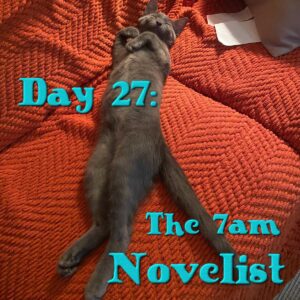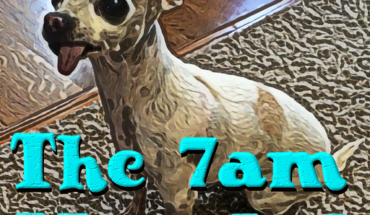 We’re over halfway through the 7am Novelist’s 50-day writing challenge, which means we should all be halfway through our books! I’m kidding, of course. If you’re like me, you’re still on the dark side of the mountain, waiting to reach the peak when the rest of the way becomes clear. Luckily, we have GrubStreet instructor and author Michelle Hoover guiding us through the darkness.
We’re over halfway through the 7am Novelist’s 50-day writing challenge, which means we should all be halfway through our books! I’m kidding, of course. If you’re like me, you’re still on the dark side of the mountain, waiting to reach the peak when the rest of the way becomes clear. Luckily, we have GrubStreet instructor and author Michelle Hoover guiding us through the darkness.
Week Three: Which POV is right for you?
In week three, Hoover and her guests discussed point of view (POV), the pros and cons of each, and how you decide which one is right for you.
Even if you’re already familiar with the different POVs, it was helpful to hear from the guests about how they chose the best one for their novels and the challenges they faced with each one. For Maya Shanbhag Lang and Lauren Acampora, writing in first person gives them direct access to their character’s thoughts and emotions. Though it also means you’re limited by your character’s vocabulary, experience, and what they know. This is where secondary characters can be used to poke at your narrator, force them to think about things, and deliver information.
If you’re struggling with the limitations of first person, you might try third-person limited, which allows you to maintain intimacy with your character without losing your own writing style and descriptive abilities. Whitney Scharer finds this especially useful when writing historical fiction, because the third person narrator can act as a guide to the world without being restricted to the language of the time period you’re writing about.
Third-person omniscient is perhaps the most challenging POV. While your narrator has access to the entire story and can jump into the head of any character, as the writer, you have to make choices about what to include. As Weike Wang points out, it’s difficult to write a narrator who knows everything from the beginning when you, the author, do not. For some writers, this means finishing a first draft, then going back and figuring out when and how to transition from one character’s perspective to the next.
Hoover and her guests also touched on two POVs we see less often, namely, second-person, and first-person plural. With second-person, the author addresses the reader as “you,” and though this invites the reader to become the character, David Abrams warns that you run the risk of alienating a reader who doesn’t identify with the main character.
The first-person plural, narrated by a collective “we,” is best used for a large cast of characters that is bound together in some way. According to Allison Amend, one of the benefits of using this style of narration is that the collective “we” can know more than any one individual. Though without a single character there to do the actions, it can be difficult to keep the story moving forward.
Several of Hoover’s guests agreed that selecting your POV comes down to knowing your characters and letting the novel speak to you. Often, this means trying out different POV’s until you find one that feels right. At the same time, Amend advises us not to get too caught up in the ways we label the different POVs, saying, “In some ways we want to put them on after the fact to describe what we’ve done rather than have them be restrictive ways in which we write.”
Week Four: Unstable Ground and Inciting Incidents
In week four, Hoover and her guests discussed the early pages of the novel and what you need to set up your story and keep your readers turning the pages. This goes back to knowing your characters: what are their flaws, weaknesses, unmet desires, and needs? What is the baggage they’re already carrying before the novel begins? You need to begin with a character who is broken in some way so that they have something to overcome in the novel.
This is also known as the unstable ground. Unstable ground helps establish your character, which in turn determines your inciting incident, or the event that jumpstarts the story. As someone who has struggled to find the right inciting incident for my story, I loved Devi Snively’s reminder to be awake to what is happening on the page. The inciting incident usually comes from the wound, flaw, or unmet desire and amplifies it, so if you’ve done the work to understand your character, the inciting incident should become clear. The inciting incident leads us to the point of attack, in which the character is forced to act. For Ron MacLean, this is the first moment of urgency or tension in the novel.
And tension, simply put, is what keeps the reader turning the pages. According to Katrin Schumann, each scene and chapter need to have a question that helps move the story forward. This question can be as small as, “Is my character going to make it to their appointment on time?” or as big as the central question that drives the entire novel.
Sometimes writers make the mistake of withholding information from the reader to add mystery or tension to the story. This is something I’m certainly guilty of, so I especially enjoyed Hoover’s episode on mystery and clarity. Guests Emily Ross and Jessica Bird discussed how they create mystery in their novels without confusing the reader. Ross advises us to be clear about setting and scene, where and when we are in the story, so the reader can focus on the true mystery of the novel. For Bird, the act of writing a novel is a collaboration between writer and reader. If you obscure or give away too many details, you’re not leaving space for your reader to take part in the story.
If there’s one overarching takeaway from weeks three and four, it’s to listen to what is already unfolding on the page as you write. Follow your character’s yearnings and goals; allow setting to shape and push against your characters; look back to the events and images you’ve already written. Writing a first draft doesn’t have to be moving blindly through the dark. If you’re paying attention to what the book has already given you, Hoover says, you’ll find your way to the end.
____________________________________________________________________
The 7am Novelist writing challenge is running for 50 episodes, through November 22, with new writing topics and guests each week. Find it on major podcasting services, including Apple and Spotify, as well as on Hoover’s blog, 7amnovelist.substack.com. And don’t forget…it’s FREE!
Michelle Hoover’s most recent novel is Bottomland.
Maya Shanbhag Lang’s most recent book is the memoir What We Carry.
Lauren Acampora’s latest novel is The Hundred Waters.
Whitney Scharer’s novel is The Age of Light.
Weike Wang’s most recent novel is Joan is Okay.
David Abrams’ latest novel is Brave Deeds.
Allison Amend’s latest novel is Enchanted Islands.
Devi Snively is the director of Bride of Frankie.
Ron MacLean’s most recent short story collection is We Might As Well Light Something on Fire.
Katrin Schumann’s latest novel is This Terrible Beauty.
Emily Ross’ novel is Half in Love with Death.
Jessica Bird is a graduate of the Novel Incubator, working on a novel called The Only Brother.


